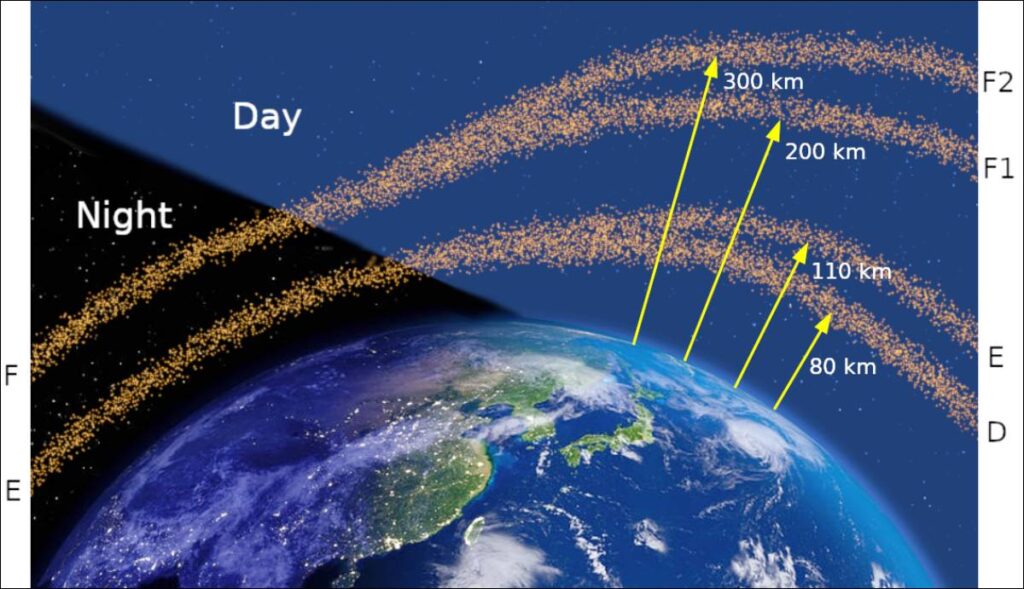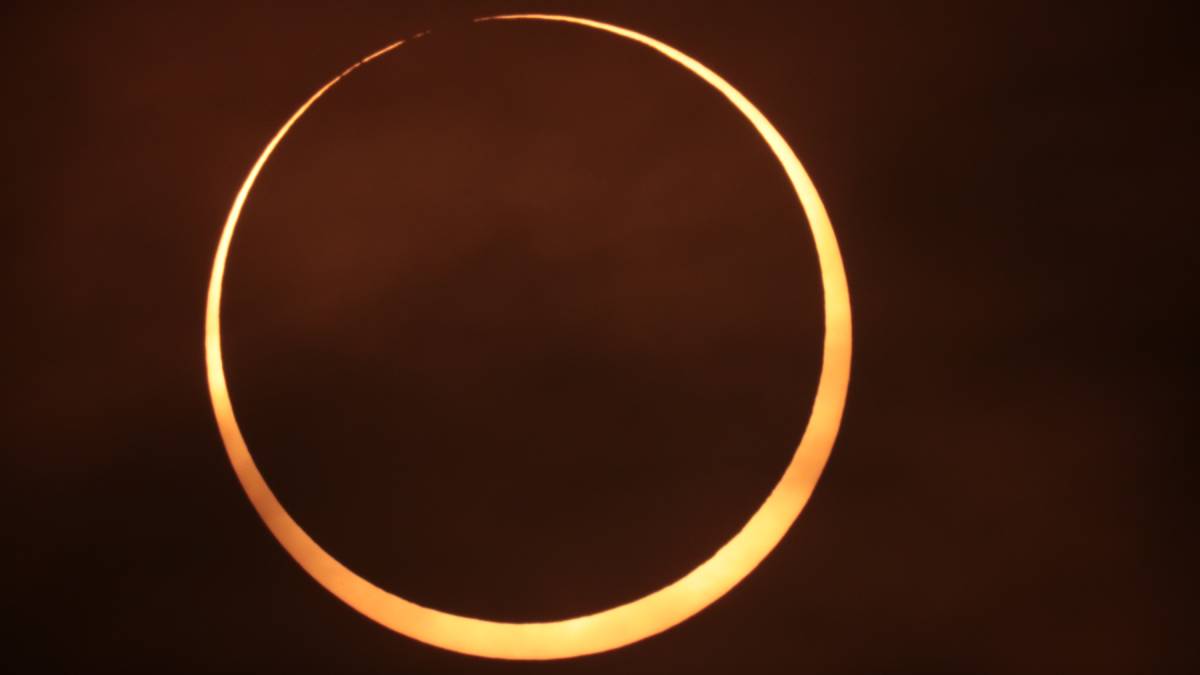This article also may be read in Portuguese.
On 14 October, millions of people in North, Central, and South America peered through safety glasses and other viewing aids at the partially obscured Sun. Simultaneously, thousands of folks experienced the annular solar eclipse in a different way: through transmissions sent and received over amateur radios.
Before, during, and after the eclipse, ham radio operators pinged signals off the ionosphere and connected to people hundreds or thousands of kilometers away. The experiment, part of NSF and NASA’s Ham Radio Science Citizen Investigation (HamSCI), is gathering hundreds of thousands of those contacts to investigate how the ionosphere responds to the temporary loss of sunlight during an eclipse.
“This is our way of remote sensing the ionosphere.”
“This is our way of remote sensing the ionosphere,” said Nathaniel Frissell (call sign W2NAF), a space physicist and electrical engineer at the University of Scranton (W3USR) in Pennsylvania and the lead HamSCI organizer. “People have been doing this for about 100 years, and it’s gamified,” he said. “We used this idea to create a ham radio contest that would actually be a scientific experiment.”
Bending Through the Air
Earth’s ionosphere, 80–600 kilometers above the ground, is a natural conduit for radio communication and navigation. Its charged particles bend the path of radio waves into an arc, enabling them to travel around the curvature of the planet from transmitter to receiver.
The ionosphere is densest during the day as high-energy sunlight ionizes molecules in the atmosphere, and it splits into four distinct sublayers segregated by density and ionization fraction, Frissell explained. A dense ionosphere helps radio transmissions travel longer distances and makes communications clearer.
At night, electrons recombine with positive ions to form neutral molecules, Frissell continued, lowering the percentage of ionized molecules and reducing the number of sublayers to just two. The lower density and fewer sublayers mean that some radio frequencies will be weakened as they travel, some will shift to higher or lower frequencies (Doppler shifting), and others might pass through the ionosphere entirely.

Depending on their frequency, radio waves will refract off the different sublayers, which are at different altitudes, affecting a signal’s range. That dependence makes shortwave, or high-frequency, radio communication networks an excellent tool to probe ionosphere fluctuations.
“An eclipse is like temporary nighttime,” Frissell said, allowing scientists to test whether the temporary darkness has the same effect on the ionosphere and radio communications as nighttime.
HamSCI was developed by ham radio operators who are also space physicists, atmospheric scientists, and communication engineers. The organizers use amateur radio to better understand ionospheric physics and its response to space weather, investigate how ionospheric disturbances affect ham radio communications, and grow awareness of and participation in the hobby’s global community.
Gamifying an Eclipse
Ham radio operators have participated in contests practically since the advent of the hobby 100 years ago, said Kristina Collins (KD8OXT), a HamSCI advisory board member and an electrical engineer at the Space Science Institute in Cleveland. During contests, hams, as operators are nicknamed, compete to make as many contacts, or QSOs, as they can within the contest’s guidelines. Operators submit their communications logs to the contest organizers, and contacts that meet parameters earn points.
“As my friend KJ4HNN likes to say, ‘You talk to as many people as possible as quickly as possible about as little as possible, and you see who can get the highest points,’” Collins quipped.

HamSCI held its first Solar Eclipse QSO Party (SEQP) during the 2017 Great American Eclipse. Before, during, and after the eclipse, HamSCI gathered 570 logs that contained nearly 30,000 contacts at 1.8-, 3.5-, 7-, and 14-megahertz frequencies. Nearly 5,000 unique call signs around the world participated. Those data helped the team understand how the total eclipse weakened the ionosphere and hindered radio communication.
The group wanted to repeat the success of 2017 during the 2023 annular solar eclipse that crossed the Americas. They set up another SEQP, put out the call, and invited any and all hams to participate. Given the eclipse’s path, the HamSCI team was especially interested in getting participation from hams operating outside of North America.
“Brazil is located near the magnetic equator,” said Edson Pereira (PY2SDR). There, plasma bubbles in the ionosphere create a lot of distortion in the radio signals, including shortwave, he explained. Pereira is a computer systems engineer and board member of Liga de Amadores Brasileiros de Rádio Emissão (LABRE), Brazil’s national amateur radio association.
Monitoring shortwave radio communications across the eclipse path in South America could help scientists better understand how plasma bubbles form and influence the surrounding atmosphere and improve satellite communication near the magnetic equator.
Results from 2023
According to Frissell, no one had yet used amateur radio data to study the ionospheric response to an annular eclipse. The HamSCI participants didn’t know what, if any, ionospheric response they would be able to see. At the top of their list of science questions: “Can the annular eclipse be observed in high-frequency communications?” Frissell asked.

The answer came quickly and was a resounding yes! As the eclipse began to locally collapse sublayers of the ionosphere, the distance a wave had to travel to reach the ionosphere changed. This Doppler shifted the frequency before it arrived at a receiver, and that Doppler shift appeared very clearly in preliminary data.
Answering other science questions—about the size and duration of the ionospheric disturbance, how different ionosphere layers responded, and whether eclipse communications resemble those taken at dawn and dusk—will have to wait until contest participants submit their communication logs.
“When my station was transmitting, we would easily get 500 reception reports globally in a 15-minute period.”
The participation statistics look promising, the team said. One count during the contest showed 8,300 active receivers around the world, picking up more than 3,000 reports per second. “When my station was transmitting, we would easily get 500 reception reports globally in a 15-minute period,” Frissell said.
Logs from the SEQP are self-reported; a few days after the eclipse, 139 logs had been submitted, each containing potentially hundreds of contacts. “There are likely more coming,” Frissell said. “I haven’t submitted my SEQP log yet!”
Repeating the Experiment
The 2023 SEQP was one of several events that HamSCI plans to hold as part of its Festivals of Eclipse Ionospheric Science. “An eclipse is the closest thing you can get to a controlled experiment in space,” Collins said. “That’s the appeal.”
Experiments, after all, should be repeatable. There is an SEQP contest for the April 2024 total solar eclipse, and HamSCI will be looking to see whether the ionosphere responds the same way (near solar maximum) as it did in 2017 (near solar minimum), Frissell said.
Each contest also provides opportunities for the team to engage with students and increase interest in amateur radio. Many ham radio operators got involved with the hobby when they were young, and for some it drove them to pursue a STEM (science, technology, engineering, and mathematics) education. “It gives a really solid STEM canon that has been boiled down into very straightforward training,” Collins said.
—Kimberly M. S. Cartier (@AstroKimCartier), Staff Writer
This news article is included in our ENGAGE resource for educators seeking science news for their classroom lessons. Browse all ENGAGE articles, and share with your fellow educators how you integrated the article into an activity in the comments section below.


